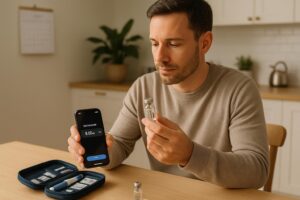How Long Does GLP-1 Last in the Fridge? Essential Storage Insights for Effective Weight Management

Introduction
Did you know that improper storage of medications can significantly impact their effectiveness? For individuals using GLP-1 medications, understanding how to store them properly is crucial for ensuring that they work as intended. With the popularity of GLP-1 receptor agonists, such as Semaglutide and Tirzepatide, on the rise for weight management, knowing how long these medications last in the fridge becomes a pertinent question.
GLP-1 medications are designed to help individuals manage their weight and improve overall health. These medications are often sensitive to temperature changes, and how we store them can directly affect their potency and safety. In this blog post, we will explore the essential aspects of GLP-1 storage, specifically focusing on how long these medications last when stored in the refrigerator, the importance of proper storage, and best practices for handling them.
By the end of this article, you will have a comprehensive understanding of GLP-1 medication storage, and you’ll feel more empowered in your weight management journey. We will cover:
- Understanding GLP-1 Medications: A brief overview of what GLP-1 medications are and their role in weight management.
- Storage Guidelines: Detailed guidelines on how to store GLP-1 medications, including optimal temperature ranges and how long they last in the fridge.
- What Happens When GLP-1 Medications Are Not Stored Properly: The implications of improper storage and how it affects medication efficacy.
- Travel Tips: Best practices for traveling with GLP-1 medications to maintain their effectiveness.
- Conclusion and FAQs: A summary of key points and answers to common questions related to GLP-1 storage.
This article aims to provide clarity on the often-overlooked aspect of medication storage. With our commitment to personalized and effective weight management solutions at TrimRx, we believe that understanding these details can make a significant difference in your health journey.
Understanding GLP-1 Medications
GLP-1 receptor agonists, such as Semaglutide and Tirzepatide, mimic the effects of the glucagon-like peptide-1 hormone, which plays a crucial role in regulating appetite and insulin secretion. These medications have gained attention not only for their efficacy in managing type 2 diabetes but also for their significant impact on weight loss.
As we embark on our weight management journey, it’s essential to recognize that these medications can help us make sustainable lifestyle changes. However, their effectiveness relies heavily on proper use and storage.
Types of GLP-1 Medications
- Semaglutide: Available in both injectable forms like Ozempic® and Wegovy®, Semaglutide has shown remarkable results in weight loss and diabetes management.
- Tirzepatide: A newer addition to the GLP-1 family, it combines the effects of GLP-1 and GIP (Gastric Inhibitory Polypeptide) to enhance weight loss further.
Understanding these medications is the foundation of utilizing them effectively. However, even the most effective medication can become ineffective if not stored correctly.
Storage Guidelines
When it comes to GLP-1 medications, proper storage is paramount. Here’s what you need to know about how long these medications last in the fridge and the best practices for storage.
Optimal Storage Temperature
GLP-1 medications should generally be stored in a refrigerator at a temperature between 36°F to 46°F (2°C to 8°C). This range ensures that the medication remains stable and effective.
How Long Do GLP-1 Medications Last in the Fridge?
-
Unopened Vials: If the medication is unopened, it will remain effective until the expiration date indicated on the packaging, provided it has been stored correctly in the refrigerator.
-
Opened Vials:
- Semaglutide (Ozempic® and Wegovy®): Once opened, these medications typically remain effective for 30 days when stored in the fridge.
- Tirzepatide: Similar to Semaglutide, once this medication is opened, it also lasts about 30 days in the fridge.
It’s essential to adhere to these timeframes to ensure that you receive the full benefits of the medication.
Why Does Storage Matter?
Storing GLP-1 medications at the recommended temperature and duration is crucial for several reasons:
- Efficacy: Temperature fluctuations can lead to degradation of the active ingredients, reducing the medication’s effectiveness.
- Safety: Medications that have been stored improperly may not only be ineffective but could also pose health risks if they have degraded in harmful ways.
Summary of Storage Guidelines
- Keep GLP-1 medications in the fridge between 36°F to 46°F (2°C to 8°C).
- Unopened vials are effective until the expiration date.
- Opened vials should be discarded after 30 days.
By following these guidelines, we can ensure that our medications work optimally, supporting our weight loss and health goals effectively.
What Happens When GLP-1 Medications Are Not Stored Properly?
Understanding the consequences of improper storage can help us appreciate the importance of following the outlined guidelines. Here are some potential risks associated with improper storage:
Reduced Effectiveness
If GLP-1 medications are exposed to temperatures outside the recommended range, they may lose potency. For example, keeping them at room temperature or exposing them to light can lead to significant degradation of the active ingredients.
Increased Risk of Side Effects
Using medications that have degraded due to improper storage may lead to unpredictable side effects. These side effects can range from mild discomfort to more severe reactions, depending on the extent of the degradation.
Waste of Resources
Improperly stored medications often lead to unnecessary waste. Discarding effective medication simply because it was not stored correctly can be frustrating and costly, especially for individuals relying on these treatments for their health.
Conclusion on Storage Considerations
The risks associated with improper storage highlight why we must prioritize understanding how to store our medications correctly. By adhering to the guidelines provided, we can maximize the efficacy of GLP-1 medications and support our health effectively.
Travel Tips for GLP-1 Medications
Traveling with GLP-1 medications can be daunting, especially when considering their storage requirements. However, with a bit of planning, you can ensure that your medications remain effective while you’re on the go. Here are some essential tips:
Use an Insulated Cooler Bag
When traveling, keep your medications in an insulated cooler bag with ice packs. This helps maintain a stable temperature and protects the medications from heat exposure.
Carry-On Luggage
If you are flying, always keep your medications in your carry-on luggage. This ensures that you have control over the temperature and prevents exposure to extreme temperatures found in cargo holds.
Stay at Locations with Refrigeration
When booking accommodations, choose hotels that offer refrigerators in the rooms. This allows you to store your medications safely during your stay.
Pack Extra Medication
It’s wise to bring extra medication in case of unforeseen circumstances, such as a vial getting broken or damaged during travel.
Monitor Temperature
If your GLP-1 medication has been exposed to temperatures outside the recommended range, consult with your healthcare provider or pharmacist on the best course of action.
Summary of Travel Tips
Traveling with GLP-1 medications requires careful planning to ensure their effectiveness. By using insulated bags, keeping them in carry-ons, and choosing accommodations with refrigeration, we can manage our medications effectively on the road.
FAQ
As we conclude our exploration of how long GLP-1 medications last in the fridge, it’s clear that proper storage and handling are critical to maintaining their effectiveness. By adhering to recommended storage practices, we can ensure our weight management journey remains on track, supported by effective medications.
FAQ
Can I store GLP-1 medications at room temperature?
No, GLP-1 medications should be stored in the fridge. Keeping them at room temperature can lead to degradation.
What should I do if my medication has been exposed to high temperatures?
Consult your healthcare provider or pharmacist for guidance. They may recommend discarding the medication and obtaining a new vial.
How can I tell if my medication is still effective?
Check for any changes in color, clarity, or consistency. If you notice anything unusual, consult your healthcare provider.
Can I use GLP-1 medications after the 30-day mark once opened?
It is not recommended. For safety and efficacy, discard any opened medication after 30 days.
How do I properly dispose of expired or unused medications?
Follow local regulations for medication disposal, or return them to a pharmacy that offers medication take-back programs.
By understanding the significance of GLP-1 medication storage and following best practices, we can harness their full potential in our weight management efforts. At TrimRx, we are dedicated to supporting your journey to a healthier lifestyle with personalized solutions and compassionate care. If you’re considering GLP-1 medications as part of your weight loss journey, we encourage you to take our free assessment quiz to discover the best options tailored for you. Together, let’s navigate your path to success!

Transforming Lives, One Step at a Time
Keep reading
7 Tips for Sticking to GLP-1 Injection Schedules
Seven practical strategies to keep weekly GLP‑1 injections on schedule—pick a routine day, set reminders, manage side effects, rotate sites, and avoid missed doses.
Custom GLP-1 Dosing for Kidney Disease
Personalized GLP-1 dosing for CKD patients with monitoring, dehydration and hypoglycemia risk mitigation, and guidance across all kidney disease stages.
Semaglutide vs Tirzepatide: Approved Uses
Two leading diabetes and weight-loss drugs differ in FDA-approved benefits — one adds heart, kidney and liver protection; the other treats obstructive sleep apnea.



